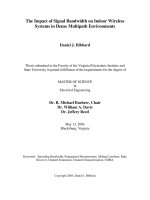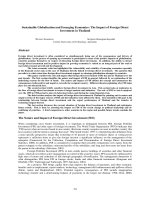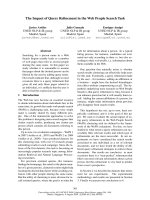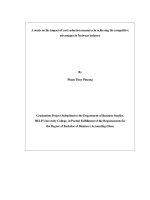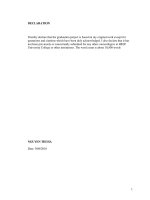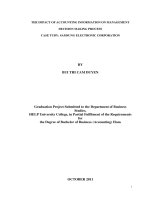The impact of COVID-19 pandemic on the smooth transition dynamics of broad-based indices volatilities in Taiwan
Bạn đang xem bản rút gọn của tài liệu. Xem và tải ngay bản đầy đủ của tài liệu tại đây (1.2 MB, 19 trang )
Journal of Applied Finance & Banking, Vol. 10, No. 5, 2020, 261-279
ISSN: 1792-6580(print), 1792- 6599(online)
Scientific Press International Limited
The Impact of COVID-19 Pandemic on the Smooth
Transition Dynamics of Broad-based Indices
Volatilities in Taiwan
Day-Yang Liu1, Chun-Ming Chen2 and Yi-Kai Su3
Abstract
This study adopts the smooth transition Generalized Autoregressive Conditional
Heteroscedastic (GARCH) model to depict the influences of the Novel Coronavirus
Disease (COVID-19) on the dynamic structure of the broad-based indices volatility
in Taiwan. The empirical results show that the episode of the COVID-19 switches
the volatility structure for the most of indices volatilities except two industrial subindices, the building materials and construction index and the trading and consumer
goods index. Furthermore, we obtain the transition function for all indices
volatilities and catch that their regime adjustment processes start prior to the
outbreak of COVID-19 pandemic in Taiwan except two industrial sub-indices, the
electronics index and the shipping and transportation index. Additionally, the
estimated transition functions show that the broad-based indices volatilities have Ushaped patterns of structure changes except the trading and consumer goods subindices. This study also calculated the corresponding calendar dates of regime
change about dynamic volatility pattern.
JEL classification numbers: G00, G10
Keywords: COVID-19, ST-GARCH, volatility, structure change.
1
2
3
Graduate Institute of Finance, National Taiwan University of Science and Technology.
Graduate Institute of Finance, National Taiwan University of Science and Technology.
Graduate Institute of Finance, National Taiwan University of Science and Technology.
Article Info: Received: May 19, 2020. Revised: June 3, 2020.
Published online: July 1, 2020.
262
Day-Yang Liu et al.
1. Introduction
For the recent decade, global financial markets have suffered several dramatic
shocks including the 911 attacks in 2001, subprime crisis in the fall of 2007,
Lehman Brothers collapse on September 2008, 2009 European sovereign-debt crisis
and 2018-2019 US-China trade war etc. Most of these financial shocks could be
directly attributed to equities or capital market decline. However, it is rare to
observe that the infectious disease episodes cause the financial market turmoil. In
addition, the volatility is widely used in asset pricing and hedge, risk management,
portfolio selection and the other financial events. For this reason, we attempt to
detect whether the COVID-19 pandemic incident will trigger the dynamic volatility
changes.
The COVID-19 pandemic distribute from a regional disease in East Asia to a global
infectious disease. According to the outbreak situation from the World Health
Organization (WHO) website, the confirmed cases are about 4 million, and
confirmed deaths are about 300 thousand as of 10th May 2020. In the face of this
serious infection, many governments adopt entry restrictions, social distancing
mandates and put on lockdown. However, the above containment policy might
directly decrease the labor inputs and further harm the economic, as argued by
Baldwin and Tomiura (2020). The characters of infectious disease episodes are
dissimilar to that of economic crisis. Governments usually use the containment
policy bringing economic damage to deal with the former mishap, but take the
quantitative easing policy stimulating economic growth to handle the latter incident.
Therefore, it is reasonable to comprehend the influences of the containment policy
promulgated by infectious disease on dynamic volatility structure are significant or
not.
In this study, firstly, we apply the modified GARCH model with threshold variable
to fit the broad-based indices volatility in Taiwan, since this model is easy to use as
the break time is certain.4 To avoid the biased estimates of regime-switching date,
we further employ the smooth transition GARCH model (ST-GARCH for short) to
capture the broad-based indices volatility. By the specification of the ST-GARCH
model, we could effortlessly explore the regime break date for broad-based indices
as the volatility structure change is truly being.
Generally speaking, the grave epidemic might lead to stocks plummet and market
volatility surges. However, we discover that the COVID-19 pandemic switches the
dynamic volatility from the high level to low case for the most of indices during our
sample period. We conjecture that this phenomenon could be attributed to two
factors. Firstly, the government seems succeeded in increasing the COVID-19
treatment efficiency and diminishing the spillover effect to economy. The relative
evidences refer to the statistical data from Deep Knowledge Group website.
Secondly, the event of US-China trade war dominated the indices volatility in
Taiwan. According to the official statistical data, Taiwan gains the most trade
4
We assume the threshold variable as the time of outbreak of the COVID-19. In Taiwan the date of
outbreak of COVID-19 is 21th January 2020.
The Impact of COVID-19 Pandemic on the Smooth Transition Dynamics…
263
diversion effects about 4.2 billion from the US-China trade war. For this reason, the
impact of the US-China trade war drives the dynamic volatility in high regime.
The rest of this paper is arranged as follows. In section 2 we introduce the related
GRACH models and ST-GARCH model. The empirical analysis is reported in
section 3. Finally section 4 summarizes the results and presents the concluding
remarks.
2. Methodology
2.1
Related GARCH models
One of the noted dynamic volatility model is the GARCH model that developed by
Engle (1982) and Bollerslev (1986). The GARCH(1,1) model could be used to
depict the dynamic volatility process, that is,
Rt = t
ht = 0 + 1 t2−1 + 1ht −1
(1)
t | t −1 ~ N (0, ht ),
where Rt denotes the underlying asset returns at time t, ht denotes the conditional
volatility at time t, t2−1 denotes the square residual at time t-1, and Ωt-1 denotes the
information set at time t-1. The parameters, α0, α1 and β1, can be regarded as the
inherent uncertainty level, short-run impact of volatility shocks, and long-run effect
of volatility shocks, respectively. The specification of standard GARCH(1,1) model
could not detect the nonlinear structural changes for dynamic volatility process. In
this study, we concern about the influence of COVID-19 pandemic on the indices
volatility process, therefore it is nature to incorporate a threshold variable into the
equation (1).
That is,
ht = 0 + 0 Dt + 1 t2−1 + 1Dt t2−1 + 1ht −1 + 2 Dt ht −1 ,
(2)
where Dt represents a threshold variable taking the value 1 post-outbreak and 0 preoutbreak. We consider three threshold terms, including a single threshold term and
two cross-product terms, in the variance equation for capturing the complete
processes. On the condition that the given break date contains correct and full
information, the exogenous adjustment could be explored the data structure change.
It means that inaccurate definition of break date could cause estimating results
insignificant and biased.
264
Day-Yang Liu et al.
2.2
The smooth transition GARCH model
From past study, using the endogenous variable to nonlinear volatility model is
better to capture the structure change. The smooth transition model proposed by
Granger and Teräsvirta (1993) and Lin and Teräsvirta (1994) can diagnose the break
point by itself. A series of recently literature consider that combining the smooth
transition method with GARCH model can obtain many benefits in parameter
estimates of dynamic volatility model. 5 The ST-GARCH model provides
relatively flexible approach to widen the volatility process with nonlinear regime
changes. Furthermore, the ST-GARCH model could explicitly point out the true
date of structure changes in the data generating process for volatility process. The
generalized framework for examining the appropriateness of an estimated STGARCH type model is built by Lundbergh and Teräsvirta (2002). The ST-GARCH
model can be illustrated as,
yt = f(wt; φ) + εt ,
t = zt (ht + g t )1/ 2 ,
(3)
where ht = η′st, gt = λ′stF(τt;γ,c), wt is a regressor vector in mean, φ is the coefficient
vector,
iid
zt ~ (0,1) , st = (1, t2−1,..., t2− q , ht −1,..., ht − p )' ,
η = ( 0 ,1 ,..., q , 1 ,..., p )' ,
λ = (0 ,1,..., q , 1,..., p )' .
In particular,
k
F ( t ; , c) = (1 + exp(− ( t − ci )))−1 ,
(4)
i =1
where t denotes the transition variable at time t, denotes the slope parameter
( 0 ), c = (c1 , c2 ,..., ck ) denotes a location vector in which c1 c2 ... ck , and
k is the number of transitions. This specification implies transitions between two
regimes, F ( t ; , c) = 0 and F ( t ; , c) = 1 .
Lundbergh and Teräsvirta (2002) consider that the ST-GARCH model contains
some vantages. Firstly, the timing decision for regime change in parameters is
endogenesis in estimation and this decisive manner is more adaptable than
artificially given a priori. Secondly, the specification of GARCH model with
threshold variable belong to a special case as the slope parameter ( ) reaches to
infinity. Finally, the transition function in equation (4) provides another flexible
specification in modeling to determine the patterns of structural changes. For
example, equation (4) reduces to a special case of a chow’s structural change as
5
Also see Hagerud (1997), Gonzalez-Rivera (1998), Anderson et al. (1999), Lee and Degennaro
(2000), Lundbergh and Teräsvirta (2002), Lanne and Saikkonen (2005), Medeiros and Veiga (2009),
Chou et al. (2012) and Chen et al. (2017).
The Impact of COVID-19 Pandemic on the Smooth Transition Dynamics…
265
→ and k = 1. In another case, if the slope parameter → and k = 2,
equation (4) turn out to be a double step function.
On the basis of the suggestion from Lundbergh and Teräsvirta (2002), we examine
the hypothesis of parameter constancy in GARCH model before estimation of the
ST-GARCH model. Assuming the null model is gt = 0 and let xt = hˆt−1hˆt / η
under the null. Furthermore, we consider the transition variable to be time, t = t ,
in order to take an evaluation for the impacts of COVID-19 pandemic for the broadbased indices volatility in Taiwan. Let, vit = t i st , vˆit = t i sˆt , and vˆit = (vˆ1t , vˆ2t , vˆ3t )
for i = 1, 2, and 3.
The procedure of statistical test can be executed by an artificial regression as below.
First, estimate the parameters of the conditional model under the null. Let
T
SSR0 = (ˆt2 / hˆt − 1) 2 , and then regress (ˆt2 / hˆt − 1) on xt , vˆt and collect the
t =1
sum of squared residuals, SSR1 . The LM-version test statistic can be computed by
LM = T ( SSR0 − SSR1 ) / SSR0 . On the other hand, the F-version test statistic can be
calculated by F = (( SSR0 − SSR1 ) / k / SSR1 /(T − p − q − 1 − k )) . We adopt the
statistics to ascertain an appropriate k to specify the ST-GARCH models. The
choosing criterion of k value is the smallest p-values.
3. Data and empirical results
In this article, we concern about the broad-based indices volatility for the COVID19 pandemic in Taiwan. We select several broad-based indices including TAIEX,
Electronics (ELEC), Plastic and chemical (CHEM), Food (FOOD), Iron and steel
(STEEL), Building materials and construction (BUILD), Tourism (TOUR), Finance
and insurance (FIN), Trading and Consumer goods (TRAD), Biotechnology and
medical care (BIO) and Shipping and transportation (SHIP). Daily data of 11 broadbased indices for the period 2 April 2015 to 1 April 2020 are adopted and collected
from Taiwan Stock Exchange (TWSE). In Figure 1, the daily closing prices for all
broad-based indices are respectively graphed. The daily indices returns are
calculated by taking the first difference of the logarithmic prices. Descriptive
statistics for these daily indices returns are reported in Table 1. We separate the
whole period into two sub-sample periods by the infections disease outbreaks of
COVID-19. Most of the items of summary statistics for the pre- and post-outbreak
phase seem different. It is necessary for us to check whether the difference is
significantly existence or not. According to the significance of the Ljung-Box Q2
statistics for all indices returns, we can infer that the GARCH family model is proper
to fit them.
266
Day-Yang Liu et al.
Figure 1: Daily closing prices for broad-based indices over the period 2 April
2015 to 1 April 2020
The Impact of COVID-19 Pandemic on the Smooth Transition Dynamics…
267
Table 1: Descriptive Statistics
Before COVID-19 pandemic (2 April 2015 to 20 January 2020)
Mean
St.D
Skewness Kurtosis Maximum Minimum
Q2(10)
TAIEX
0.020
0.830
-0.870
6.358
3.518
-6.521
317.75*
ELEC
0.028
1.000
-0.547
3.904
4.449
-6.868
273.76*
CHEM
0.004
0.887
-0.881
7.783
4.085
-7.661
250.05*
FOOD
0.031
0.941
-0.479
3.525
3.816
-6.611
247.41*
STEEL
0.002
0.912
0.073
5.686
4.927
-5.613
242.22*
BUILD
0.004
0.808
-1.340
14.291
4.197
-7.962
382.23*
TOUR
-0.016
0.978
-0.212
3.635
3.844
-6.768
309.68*
FIN
0.018
0.834
-0.429
5.338
4.547
-5.062
287.92*
TRAD
0.006
1.050
-0.986
6.803
3.873
-7.614
293.37*
BIO
-0.012
1.150
-1.044
6.467
4.081
-8.206
262.35*
SHIP
-0.031
0.939
-0.588
7.452
4.064
-8.076
271.37*
After COVID-19 pandemic (21 January 2020 to 1 April 2020)
TAIEX
-0.515
2.370
0.041
1.077
6.173
-6.005
13.277
ELEC
-0.491
2.508
0.162
0.965
6.782
-6.173
11.907
CHEM
-0.622
2.460
-0.194
1.045
5.231
-7.105
46.364*
FOOD
-0.292
1.811
0.175
1.285
5.039
-4.480
9.188
STEEL
-0.500
1.866
-0.365
2.378
5.383
-5.443
11.382
BUILD
-0.468
2.326
-0.690
2.416
4.907
-8.168
10.137
TOUR
-0.776
2.873
-0.654
1.071
5.277
-8.435
11.124
FIN
-0.509
2.297
-0.128
1.759
6.300
-7.053
14.659
TRAD
-0.162
1.532
-1.193
1.781
2.583
-4.617
6.295
BIO
-0.464
2.711
-1.139
1.780
4.431
-9.280
19.563
SHIP
-0.685
2.368
-0.796
1.267
4.219
-7.683
12.627
Notes: This table reports the descriptive statistics for the logarithmic stock returns before and after
the starting of the COVID-19 pandemic. Q2(10) is the Ljung-Box test for serial correlation up to
10th order in the squared standardized residuals. Return is defined as 100×[log(pt)-log(pt-1)].
Significant at the 1% level is denoted by *.
In order to handle more easily for volatility data with structure change in it, we
employ the modified GAHCH model with threshold variable. The threshold
variable is embedded respectively in the intercept term, lagged squared residual
term and lagged conditional variance term for the adaptability of model
specification. Table 2 expresses the parameter estimation results of this model.
According to the significance of parameter estimates and Ljung-Box Q2 statistics,
we can infer that the impacts of COVID-19 pandemic change the most of the indices
volatilities except the TRAD industrial sub-indices. For the reason of explicitly
point out the true date of volatility structure changes of COVID-19 pandemic, it is
intuitive to employ an endogenous deciding framework, the ST-GARCH model.
268
Day-Yang Liu et al.
Table 2: The estimation of modified GARCH(1,1) model with threshold variables
Rt = t
t t −1 ~ N (0, ht )
ht = 0 + 0 Dt + 1 t2−1 + 1 Dt t2−1 + 1 ht −1 + 2 Dt ht −1
ˆ 0
ˆ 0
ˆ1
ˆ1
ˆ1
TAIEX
0.060
0.097
0.827
0.294
0.184
[<0.001] [<0.001] [<0.001] [0.034] [0.073]
LogL
-1512.101
-0.281
[0.029]
0.101
0.083
0.815
[<0.001] [<0.001] [<0.001]
7.317
2.106
[0.695] [0.995]
-1738.132
CHEM
0.052
0.089
0.853
0.255
0.199
-0.350
5.130
1.556
[<0.001] [<0.001] [<0.001] [<0.001] [0.019] [<0.001] [0.882] [0.999]
0.031
0.040
0.926
0.404
0.207
-0.567 19.428 2.745
[<0.001] [<0.001] [<0.001] [0.015] [0.023] [0.016] [0.035] [0.987]
-1571.540
STEEL
0.016
0.070
0.915
0.189
0.200
-0.355 14.238 2.353
[<0.001] [<0.001] [<0.001] [<0.001] [0.001] [<0.001] [0.162] [0.993]
-1543.541
BUILD
0.055
0.155
0.783
0.260
0.345
-0.411 21.992 2.105
[<0.001] [<0.001] [<0.001] [<0.001] [0.002] [<0.001] [0.015] [0.995]
-1426.792
TOUR
0.131
0.097
0.782
[<0.001] [<0.001] [<0.001]
0.424
[0.004]
0.221
[0.098]
-0.437
[0.016]
5.266
5.507
[0.873] [0.855]
-1730.938
FIN
0.037
0.125
0.834
[<0.001] [<0.001] [<0.001]
0.107
0.117
0.793
[<0.001] [<0.001] [<0.001]
0.173
[0.004]
0.119
[0.568]
0.200
[0.020]
-0.160
[0.030]
-0.283
[0.001]
0.225
[0.214]
6.061
2.861
[0.810] [0.985]
8.800
3.204
[0.551] [0.976]
-1459.292
BIO
0.080
0.162
0.791
[<0.001] [<0.001] [<0.001]
0.277
[0.010]
0.257
-0.298 16.478 6.144
[0.012] [<0.001] [0.087] [0.803]
-1817.726
SHIP
0.552
0.138
0.405
[<0.001] [<0.001] [<0.001]
0.244
[0.173]
0.275
[0.038]
-1693.704
TRAD
0.135
[0.121]
-0.311
[0.008]
Q(10) Q2(10)
6.281
1.556
[0.791] [0.999]
ELEC
FOOD
0.488
[0.059]
ˆ 2
-0.172
[0.039]
16.844 12.581
[0.078] [0.248]
-1658.020
-1756.537
Notes: The number in brackets is p-value. Normality tests are based on the Bera-Jarque statistics. Q(10) is the
Ljung-Box (1978) testfor serial correlation up to the 10th order in the standardized residuals, Q2(10) is the LjungBox test for serial correlation up to 10th orderin the squared standardized residuals. Before 20, Jan., 2020, the
threshold variable Dt is 0. After 21, Jan., 2020, the threshold variable Dtis 1.
Before using the ST-GARCH model to estimate, we have to test the parameter
constancy by the LM test developed by Lundbergh and Teräsvirta (2002). We
calculate the LM statistics for k = 1, 2, and 3. Furthermore we assume that the null
model is standard GARCH(1,1) model. Table 3 reports that the parameter constancy
is violated for all broad-based indices. That is to say the regime change in dynamic
volatility process is certainly being against the corresponding GARCH model. In
addition, we also detect that the parameter, k = 2, has the smallest p-value for the
The Impact of COVID-19 Pandemic on the Smooth Transition Dynamics…
269
most of broad-based indices except the TRAD sub-indices. Theses empirical results
can support us to adopt the ST-GARCH(1,1) model with k =2 to diagnose the
dynamic volatility process. Our detailed model specification is given by,
Rt = t ,
t = zt (ht + g t )1 / 2 ,
(5)
ht = 0 + 1 t2−1 + 1ht −1 ,
g t = ( 0 + 1 t2−1 + 1ht −1 ) F (t ; , c ) ,
k
where F (t; , c) = (1 + exp(− ( t − ci )))−1 . We list the parameter estimates for
i =1
the ST-GARCH(1,1) model in Table 4. Meanwhile, the estimated results for the
GARCH(1,1) model are provided in Table 5 for the purpose of comparison.
270
Day-Yang Liu et al.
Table 3: LM tests of parameters constancy for k=1, 2, and 3
LM = T
(SSR0 − SSR1 )
SSR0
k
1
2
TAIEX
1.917
8.632
[0.590]
[0.195]
ELEC
3.231
9.989
[0.357]
[0.125]
CHEM
1.115
5.632
[0.774]
[0.466]
FOOD
1.281
4.749
[0.733]
[0.576]
STEEL
1.786
6.393
[0.618]
[0.381]
BUILD
0.054
6.345
[0.997]
[0.386]
TOUR
1.963
5.093
[0.580]
[0.532]
FIN
4.116
14.180
[0.249]
[0.028]
TRAD
0.659
1.893
[0.883]
[0.929]
BIO
1.910
6.940
[0.591]
[0.326]
SHIP
0.271
6.724
[0.965]
[0.347]
Note: The number in brackets is p-value.
3
11.029
[0.472]
12.870
[0.351]
8.721
[0.776]
5.146
[0.856]
11.195
[0.700]
7.561
[0.705]
6.196
[0.826]
15.826
[0.116]
4.414
[0.993]
8.258
[0.643]
8.292
[0.666]
Table 4: The estimation of the ST-GARCH model
Rt = t
ht = 0 + 1 t2−1 + 1 ht −1 + [ 0 + 1 t2−1 + 1 ht −1 ]F (t )
k
F (t ) = (1 + exp( − ( i − ci ))) −1
i =1
ˆ 0
ˆ1
ˆ1
kˆ
ˆ
cˆ1
cˆ2
ˆ 0
ˆ1
ˆ0
Q(10)
Q2(10)
LogL
Regime 1
Regime 2
TAIEX
0.059
[<0.001]
0.147
[<0.001]
0.760
[<0.001]
2
17519.77
[0.937]
0.094
[<0.001]
0.355
[<0.001]
0.291
[0.009]
0.002
[0.961]
-0.167
[0.156]
6.051
[0.811]
2.948
[0.983]
-1497.197
0.907
0.742
ELEC
0.162
[0.017]
0.052
[0.002]
0.814
[<0.001]
2
1310.840
[0.915]
0.556
[<0.001]
0.978
[<0.001]
-0.121
[0.083]
0.049
[0.061]
0.042
[0.563]
7.829
[0.645]
3.320
[0.973]
-1733.604
0.957
0.866
CHEM
0.029
[0.764]
0.093
[0.295]
0.868
[<0.001]
2
17704.82
[0.103]
0.061
[<0.001]
0.652
[0.999]
0.843
[0.011]
0.238
[0.085]
-0.665
[0.010]
5.806
[0.831]
1.454
[0.999]
-1541.703
0.961
0.534
FOOD
0.023
[0.001]
0.017
[0.005]
0.034
[<0.001]
0.049
[<0.001]
0.937
[<0.001]
0.915
[<0.001]
2
1492.512
[0.725]
13299.46
[0.826]
0.027
[0.001]
0.151
[<0.001]
0.357
[<0.001]
0.357
[<0.001]
0.406
[0.086]
0.279
[<0.001]
0.148
[0.160]
0.184
[<0.001]
-0.331
[0.078]
-0.336
[<0.001]
17.646
[0.061]
13.180
[0.214]
4.193
[0.938]
5.169
[0.880]
-1651.251
0.971
0.788
-1534.114
0.964
0.812
BUILD
0.345
[0.091]
0.220
[0.013]
0.566
[0.007]
2
6543.094
[0.517]
0.006
[0.365]
0.076
[<0.001]
-0.229
[0.263]
0.029
[0.746]
0.017
[0.936]
23.812
[0.008]
1.525
[0.999]
-1422.122
0.786
0.832
TOUR
0.016
[0.062]
0.017
[0.157]
0.951
[<0.001]
2
3477.490
[0.027]
0.267
[<0.001]
0.361
[<0.001]
0.495
[<0.001]
0.297
[<0.001]
-0.655
[<0.001]
7.187
[0.708]
5.427
[0.861]
-1720.584
0.968
0.610
FIN
0.071
[<0.001]
0.191
[<0.001]
0.666
[<0.001]
2
15799.67
[0.878]
0.094
[<0.001]
0.357
[<0.001]
0.321
[0.022]
-0.030
[0.644]
-0.053
[0.694]
7.459
[0.682]
3.365
[0.971]
-1426.526
0.857
0.774
TRAD
0.184
[<0.001]
0.147
[<0.001]
0.703
[<0.001]
1
238.701
[0.744]
0.672
[<0.001]
-0.141
[0.007]
-0.067
[0.054]
0.182
[0.016]
7.392
[0.688]
2.910
[0.983]
-1755.774
0.965
0.850
STEEL
BIO
2
0.170
0.249
0.595
2
20387.97
0.086
0.409
0.586
0.018
-0.103
20.027
6.859
-1799.619
0.844
0.759
[0.008]
[0.036] [<0.001]
[0.975] [<0.001] [0.964]
[0.097]
[0.897]
[0.606] [0.029] [0.739]
SHIP
0.20
0.207
0.622
2
4697.755
0.067
0.366
0.557
-0.055
-0.091
9.560
0.797
-1587.503
0.829
0.683
[<0.001] [<0.001] [<0.001]
[0.982] [<0.001] [0.978]
[0.292]
[0.333]
[0.754] [0.480] [0.999]
Note: The number in brackets is p-value. Normality tests are based on the Bera-Jarque statistics. Q(10) is the Ljung-Box (1978) test for serial correlation up to the 10 th order in the
standardized residuals, Q2(10) is the Ljung-Box test for serial correlation up to 10th order in the squared standardized residuals. The regime 1 and 2 shows the upper and lower regime
individually.
272
Day-Yang Liu et al.
Comparing the figures of parameter estimates in Table 4 and 5, we find that the
existence of serial correlation up to the 10th order in the standardized residuals and
residuals squared for both models exhibit almost insignificant for all broad-based
indices. In Table 4, the volatility persistent effect for regime 1 is stronger than that
for regime 2 except the BUILD sub-indices. This finding indicates that the episode
of the COVID-19 pandemic weaken the persistence of shocks for volatility. In
addition, we observe that the volatility persistent effect of the GARCH model is
relatively excessive than that of the ST-GARCH model. Figure 2 plots the estimated
transition function, F(t). Apart from F(t) for the TRAD sub-indices, the others
display the U-shaped. In terms of regime specification, we define the upper regime
as F(t) = 1, and the lower regime as F(t) goes to its minimum value. The minimum
values of estimation of smooth transition function are zero for all broad-based
indices.
The Impact of COVID-19 Pandemic on the Smooth Transition Dynamics…
273
Table 5: The estimation of GARCH(1,1) model
Rt = t
t t −1 ~ N (0, ht )
ht = 0 + 1 t2−1 + 1 ht −1
ˆ 0
ˆ1
ˆ1
Q(10) Q2(10)
LogL
Persistence
TAIEX
0.057
0.128
0.810
6.800
1.850 -1520.700
0.938
[<0.001] [<0.001] [<0.001] [0.744] [0.997]
ELEC
0.050
[0.001]
0.098
0.864
7.643
2.979 -1744.309
[<0.001] [<0.001] [0.664] [0.982]
0.962
CHEM
0.073
0.125
0.800
7.310
1.076 -1581.951
[<0.001] [<0.001] [<0.001] [0.696] [0.999]
0.064
0.071
0.863
16.568 2.863 -1665.322
[<0.001] [<0.001] [<0.001] [0.084] [0.984]
0.925
STEEL
0.027
0.107
0.872
15.108 3.513 -1556.743
[<0.001] [<0.001] [<0.001] [0.128] [0.967]
0.979
BUILD
0.075
0.213
0.715
24.751 1.824 -1434.666
[<0.001] [<0.001] [<0.001] [0.006] [0.998]
0.928
TOUR
0.221
0.155
0.649
6.208
4.298 -1739.621
[<0.001] [<0.001] [<0.001] [0.797] [0.933]
0.804
FIN
0.042
0.163
0.801
6.578
2.920 -1468.427
[<0.001] [<0.001] [<0.001] [0.795] [0.983]
0.118
0.129
0.775
7.754
3.291 -1758.215
[<0.001] [<0.001] [<0.001] [0.653] [0.974]
0.964
BIO
0.101
0.213
0.739
18.784 5.163 -1825.177
[<0.001] [<0.001] [<0.001] [0.043] [0.880]
0.952
SHIP
0.066
0.114
0.828
14.341 0.711 -1650.804
[<0.001] [<0.001] [<0.001] [0.158] [0.999]
0.942
FOOD
TRAD
0.934
0.904
Notes:The number in brackets is p-value. Normality tests are based on the Bera-Jarque
statistics. Q(10) is the Ljung-Box (1978) test for serial correlation up to the 10th order in the
standardized residuals, Q2(10) is the Ljung-Box test for serial correlation up to 10th order in the
squared standardized residuals.
274
Day-Yang Liu et al.
ELEC
TAIEX
1
1
0
0
CHEM
FOOD
1
1
0.5
0.5
0
0
STEEL
BUILD
1
1
0.5
0.5
0
0
TOUR
FIN
1
1
0.5
0.5
0
0
TRAD
BIO
1
1
0.5
0.5
0
0
SHIP
1
0.5
0
Figure 2: Estimated smooth transition functions for broad-based indices
The Impact of COVID-19 Pandemic on the Smooth Transition Dynamics…
275
We use the persistence coefficients reported in Table 4 and 5 to measure the
dynamic volatility half-life. This could be explained as the time taken for the
dynamic volatility to move halfway back to its own unconditional volatility. All in
all, the period of the outbreak of COVID-19 pandemic contains low volatility halflife. This finding implied that the impact of shocks has been rapidly reflected in
unconditional volatility after the COVID-19 pandemic.
Table 6: The estimation of volatility half-life for different regimes of ST-GARCH
model
ST-GARCH model
Board-based indices
Regime 1 half-life Regime 2 half-life
TAIEX
7
2
ELEC
16
5
CHEM
17
1
FOOD
24
3
STEEL
19
3
BUILD
3
4
TOUR
21
1
FIN
4
3
TRAD
19
4
BIO
4
3
SHIP
4
2
Notes: The half-life could be calculated by 0.5 = e yln( ) .
GARCH model
Half-life
11
18
9
10
33
9
3
19
7
14
12
Our article also uses the estimation of location parameters, c1 and c2 , to point out
the relatively objective structure change date for the dynamic volatility process,
which is shown in Table 7. The responses of volatilities changes for half of broadbased indices (TAIEX, CHEM, FOOD, STEEL, FIN and BIO) are happening before
the episode of the COVID-19 in Taiwan. This finding indicates that employing the
modified GARCH model with threshold variable to fit the volatility process might
use a subjective and biased determination in break time. In addition, Table 7 also
reports some intriguing phenomena that the impacts of the outbreak of COVID-19
pandemic seem inexistence for BUILD and TRAD.
276
Day-Yang Liu et al.
Table 7: The estimation of location parameters and corresponding calendar dates
Board-based indices
TAIEX
ELEC
CHEM
FOOD
STEEL
BUILD
TOUR
FIN
TRAD
BIO
SHIP
c1
0.094
0.556
0.061
0.027
0.151
0.006
0.267
0.094
0.672
0.086
0.067
Date
July 6, 2016
January 5, 2018
January 22, 2016
August 12, 2015
April 14, 2017
May 6, 2015
October 29, 2018
July 11, 2016
August 8, 2018
May 31, 2016
March 1, 2016
c2
0.355
0.978
0.652
0.357
0.357
0.076
0.361
0.357
Date
January 3, 2020
February 25, 2020
January 17, 2020
January 15, 2020
January 14, 2020
April 13, 2016
February 12, 2020
January 13, 2020
0.409
0.366
January 20, 2020
January 31, 2020
Figure 3 further shows the time varying unconditional volatility for all broad-based
indices. We could explicitly displays the shifting pattern of volatility structure by
this illustration. The dynamic unconditional volatilities for most of broad-based
indices switch from a lower level to a higher case and then it goes back to a lower
one. As to the graphs for the TRAD sub-indices in Figure 3, the switching pattern
obviously differs from that of others. We infer that the unconditional volatility
structure change for the TRAD could be attributed to the economy slowing during
the period from August, 2018 through March, 2020. Furthermore, the TRAD subindices have high connection to the business indicators. In Table4 the large
coefficients of slope parameter, , could lead to all of the switching pattern
experience sharper shifts. We clarify that the dynamic volatility process goes
upwards by the US-China trade war during our sample period. Afterward, the
outbreak of COVID-19 pandemic should rocket downwards the volatilities for
broad-based indices including the TAIEX, ELEC, CHEM, FOOD, STEEL, TOUR,
FIN, BIO and SHIP. The structure change of unconditional volatility for BUILD
industrial sub-indices could be attributed to the adjustment of housing tax policy
from government.
The Impact of COVID-19 Pandemic on the Smooth Transition Dynamics…
CV_TAIEX
277
CV_ELEC
1.8
1.15
1.3
0.95
CV_CHEM
CV_FOOD
2.4
1.96
2.2
1.86
2
CV_STEEL
CV_BUILD
2.05
1.65
1.55
0.65
CV_TOUR
CV_FIN
1.4
5.68
1.35
3.68
1.3
1.68
CV_TRAD
CV_BIO
1.234
6.7
1.214
4.7
2.7
1.194
CV_SHIP
4.07
3.07
2.07
Figure 3: Estimated unconditional variance under ST-GARCH model for
broad-based indices
278
Day-Yang Liu et al.
The estimation of ST-GARCH model in this study also has some valuable
implications. Firstly, the modified GARCH model with threshold variable seems
appropriate for fitting the dynamic volatility process. However, using the STGARCH model to fit dynamic volatility process can obtain more precise estimates
of the break time dating. Lastly, the impacts of the outbreak of COVID-19 pandemic
are really being and can switch the volatility structure of broad-based indices.
4. Conclusion
In this study, we document that the impact of the outbreak of COVID-19 pandemic
triggered structure change in volatility process for broad-based indices in Taiwan.
This study employs the standard GARCH model, the modified GARCH model with
threshold variable, and the ST-GARCH model to depict the dynamic volatility
process, respectively.
From the empirical results, we demonstrate statistically significant volatility
structure change in Taiwan’s broad-based indices by the parameter estimates of both
modified GARCH and ST-GARCH model. We find that the estimates of volatility
persistent effect from the standard GARCH model could show the relatively higher
value, as the dynamic volatility structure contains a regime change. The outbreak of
COVID-19 pandemic weakens the persistence of shocks for volatility process and
brings lower volatility half-life. Moreover, the estimates for the modified GARCH
model with threshold variable might provide biased regime-switching date in the
same situation. We also illustrate that the dynamic volatility structure for the most
of broad-based indices embedded two regime change points by the LM test
presented by Lundbergh and Teräsvirta (2002).
This article uses the estimation results of ST-GARCH model to graph the time
varying unconditional volatilities and to calculate the calendar day of break time for
all broad-based indices. The patterns of unconditional volatility for the most of
broad-based indices appear the similar inverted U-shaped. We infer that the
upwards switching in volatility could be attributed to the US-China trade war, and
the declines in volatility could be triggered by the outbreak of COVID-19 pandemic.
The empirical results show that the dynamic volatility switching dates are earlier
than the outbreak of COVID-19 pandemic for the most of broad-based indices.
The Impact of COVID-19 Pandemic on the Smooth Transition Dynamics…
279
References
[1] H. M. Anderson, K. Nam and F. Vahid, “Asymmetric nonlinear smooth
transition GARCH models,” P. Rothman (ed.), Nonlinear time series analysis
of economic and financial data, Kluwer, Boston, 1999, pp. 191-207.
[2] R. Baldwin and E. Tomiura, “Thinking ahead about the trade impact of
COVID-19,” in Economics in the Time of COVID-19, CEPR Press , 2020.
[3] T. Bollerslev, “Generalized autoregressive conditional heteroscedasticity,”
Journal of Econometrics, vol. 31, 1986, pp. 307-327.
[4] C. W. S. Chen, Z. Wang, S. Sriboonchitta and S. Lee, “Pair trading based on
quantile forecasting of smooth transition GARCH models,” The North
American Journal of Economics and Finance, vol. 39, 2017, pp. 38-55.
[5] R. Y. Chou, C. C. Wu and Y. N. Yang, “The Euro’s impacts on the smooth
transition dynamics of stock market volatilities,” Quantitative Finance, vol. 12,
2012, pp.169-179.
[6] R. F. Engle, “Autoregressive conditional heteroskedasticity with estimates of
the variance of United Kingdom inflation,” Econometrica, vol. 50, 1982, pp.
987-1007.
[7] G. González-Rivera, “Smooth transition GARCH models,” Studies in
Nonlinear Dynamics and Econometrics, vol. 3, 1998, pp. 161-178.
[8] C. W. J. Granger and T. Teräsvirta, “Modeling nonlinear economic
relationships,” New York: Oxford University Press, 1993.
[9] G. E. Hagerud, “A new non-linear GARCH model,” EFI Economic Research
Institute, Stockholm, 1997.
[10] M. Lanne and P. Saikkonen, “Nonlinear GARCH models for highly persistent
volatility,” Econometrics Journal, vol. 8, 2005, pp. 765-768.
[11] L. Lee and R. P. Degennaro, “Smooth transition ARCH models: estimation
and testing,” Review of Quantitative Finance and Accounting, vol. 15, 2000,
pp. 5-20.
[12] C. F. J. Lin and T. Teräsvirta, “Testing the constancy of regression parameters
against continuous structural change,” Journal of Econometrics, vol. 62, 1994,
pp. 211-228.
[13] S. Lundbergh and T. Teräsvirta, “Evaluating GARCH models,” Journal of
Econometrics, vol. 110, 2002, pp. 417-435.
[14] C. W. S. Chen, Z. Wang, S. Sriboonchitta and S. Lee, “Pair trading based on
quantile forecasting of smooth transition GARCH models,” The North
American Journal of Economics and Finance, vol. 39, 2017, pp. 38-55.
[15] M. C. Medeiros and A. Veiga, “Modeling multiple regimes in financial
volatility with a flexible coefficient GARCH(1,1) model,” Econometric
Theory, vol. 25, 2009, pp.117-161.

